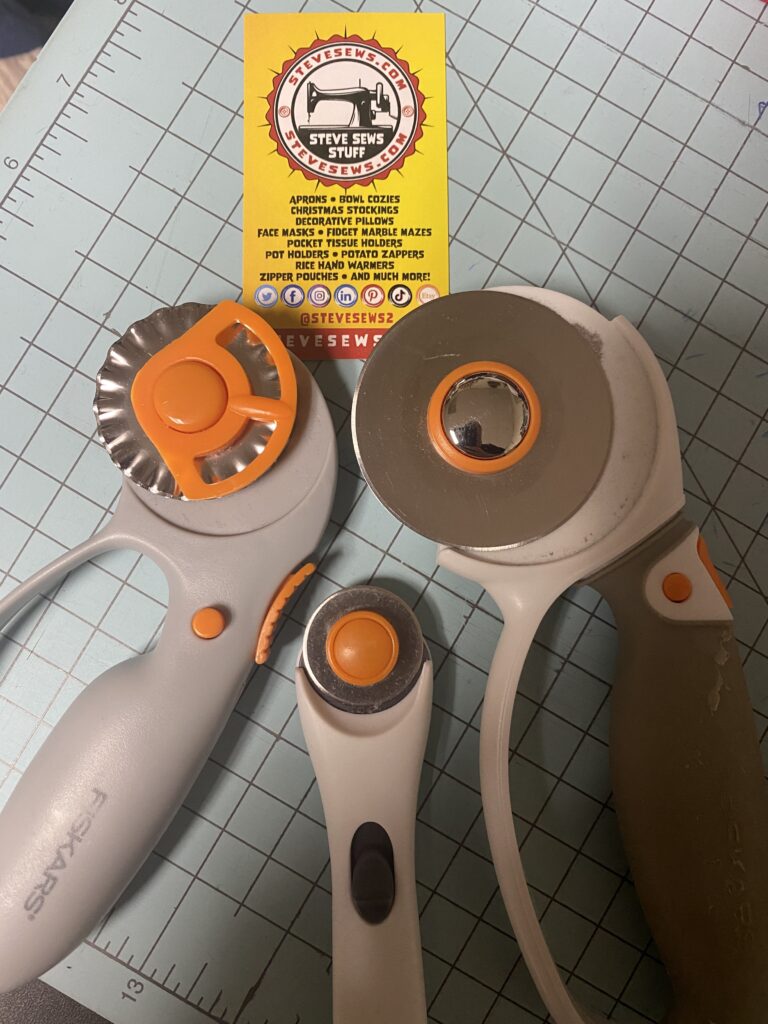Mastering Precision and Speed: Unleashing the Power of Rotary Cutters in Sewing and Quilting – When it comes to sewing and quilting, precision and efficiency are key. One tool that has revolutionized the way fabric is cut is the humble rotary cutter. Its sharp circular blade, combined with a cutting mat and ruler, makes it a game-changer for both beginners and experienced crafters. In this blog post, we’ll explore the benefits and techniques of using rotary cutters in sewing and quilting, unlocking a world of possibilities for your creative projects. #rotarycutters
Mastering Precision and Speed: Unleashing the Power of Rotary Cutters in Sewing and Quilting

- The Advantages of Rotary Cutters: Traditional scissors may have their place in certain situations, but when it comes to cutting fabric accurately and quickly, rotary cutters take the lead. Here are some of their notable advantages:
a. Precision: Rotary cutters allow you to achieve precise cuts along straight lines or intricate shapes effortlessly. The circular blade smoothly glides through layers of fabric, minimizing fraying and ensuring clean edges.
b. Speed: With a rotary cutter, you can significantly reduce the time spent on cutting fabric compared to using scissors. The blade’s efficient cutting action lets you work through multiple layers of fabric simultaneously, making it ideal for quilting projects.
c. Versatility: Rotary cutters aren’t limited to cutting fabric alone. They can also be used for cutting paper, leather, vinyl, and other materials, making them a versatile tool for various crafts.
- Essential Tools and Accessories: To make the most of your rotary cutter, you’ll need a few additional tools and accessories:
a. Cutting Mat: A self-healing cutting mat provides a protective surface for your work area and ensures that the blade glides smoothly. The mat’s grid lines also assist in measuring and aligning your fabric accurately.
b. Ruler: A clear, non-slip ruler is crucial for guiding your rotary cutter along straight lines. Look for a ruler with measurement markings that align with your preferred sewing and quilting projects.
c. Replacement Blades: Rotary cutter blades can dull over time, so it’s essential to keep spare blades on hand. Replace the blade whenever you notice it’s not cutting as smoothly as before.
- Techniques for Successful Cutting: To achieve precise and professional cuts with your rotary cutter, follow these techniques:
a. Correct Hand Placement: Hold the rotary cutter with a firm grip and place your index finger on top of the cutter’s handle, ensuring stability and control.
b. Apply Even Pressure: Apply consistent downward pressure while moving the rotary cutter in a smooth, continuous motion. Avoid pressing too hard, as it may cause the fabric to shift or distort.
c. Mindful Cutting: Pay attention to your cutting lines and take breaks if needed. Rotary cutters are sharp tools, so it’s essential to maintain focus to avoid accidents.
- Safety Precautions: While rotary cutters are efficient and versatile tools, it’s crucial to prioritize safety:
a. Blade Safety: Always retract the blade when you’re not actively cutting. Most rotary cutters come with a safety lock feature that prevents the blade from accidentally extending.
b. Storage: When not in use, store your rotary cutter in a secure place, out of reach of children and pets.
c. Protect Your Hands: Consider using a pair of cut-resistant gloves to protect your hands from accidental slips or blade mishaps.
Lesser-known facts about the Rotary Cutter
Rotary cutters are versatile tools commonly used in sewing, quilting, and crafting projects. Here are some lesser-known facts about rotary cutters:
- Invention: The rotary cutter was invented by Olfa Corporation in 1979. The company’s founder, Yoshio Okada, developed the first rotary cutter as a solution to his own frustration with traditional scissors for fabric cutting.
- Blade Shape: While most rotary cutters have circular blades, there are also models available with different blade shapes. For instance, some rotary cutters have wavy or scalloped blades, which can create decorative edges on fabric or paper.
- Blade Sizes: Rotary cutters come in various blade sizes, typically measured in millimeters. The most common sizes range from 18mm to 60mm. Smaller blades are ideal for intricate or detailed cuts, while larger blades are suitable for cutting multiple layers of fabric.
- Blade Replacement: Rotary cutter blades eventually become dull with use. However, instead of replacing the entire cutter, most models allow you to replace just the blade. This makes it more cost-effective in the long run and reduces waste.
- Safety Features: Many rotary cutters feature safety mechanisms to prevent accidental cuts. Some models have blades that retract automatically when not in use, while others require manual retraction. Additionally, some rotary cutters have blade covers or guards for added protection.
- Left-Handed Options: While most rotary cutters are designed for right-handed users, there are left-handed models available. These models feature blade placement and handle ergonomics suitable for left-handed individuals.
- Specialty Blades: In addition to the standard straight blades, rotary cutters offer specialty blades for specific tasks. Some examples include perforating blades for creating dotted lines, pinking blades for fabric edges that resist fraying, and scoring blades for paper crafting.
- Ergonomic Handles: Many rotary cutters feature ergonomic handles to reduce hand fatigue during prolonged cutting sessions. These handles are designed to provide a comfortable grip and minimize strain on the hand and wrist.
- Cutting Mats: Rotary cutters are typically used in conjunction with cutting mats. These mats are made from self-healing materials that protect surfaces from blade damage while providing a smooth cutting surface. Cutting mats also feature measurement markings for precise cuts.
- Non-Fabric Uses: Although rotary cutters are commonly associated with fabric cutting, they can also be used for various other materials. Rotary cutters can cut through paper, leather, vinyl, foam, and even lightweight metals, making them versatile tools for different crafts and hobbies.
- Pinking and Curved Blades: You can also get special rotary blades used for pinking or zig-zag cutting.
Remember to always follow safety guidelines and use rotary cutters with caution, as the blades are extremely sharp.
Conclusion:
Rotary cutters have transformed the world of sewing and quilting, offering precision, speed, and versatility. By investing in the right tools and mastering the techniques, you’ll enhance your creative projects and achieve professional results. So, grab your rotary cutter, cutting mat, and ruler, and embark on a journey of effortless fabric cutting and exquisite craftsmanship!


